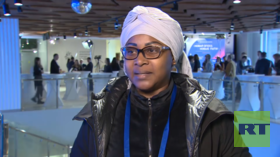First federal execution of woman in 70 years should kill illusion of American moral superiority, no matter how ‘heinous’ the crime
The US' growing embrace of the death penalty, now openly supported by the federal government, should end its pretense of moral superiority over the rest of the world. And can we stop calling the prison system “corrections,” too?
Despite having the largest prison population – both per capita and by sheer numbers – in the world, the US still unironically calls itself the “land of the free,” habitually lectures other nations about human rights, and holds itself up as a moral authority on the treatment of incarcerated human beings. This has held true even as the federal government has returned to executing prisoners with a vigor that suggests it’s making up for lost time.
The recently-scheduled execution of Lisa Montgomery should put the last, long-overdue nail in the coffin of the relentlessly hypocritical “moral authority” the US has long insisted on wielding over the rest of the world. The first female federal prisoner to be executed in nearly seven decades, loathsome as her crimes may be, is a symbol of the US’ disturbing enthusiasm for a punishment even its allies have largely discarded as barbaric.
Also on rt.com US carries out first federal execution for 17 years, after Supreme Court clears path for lethal injectionMontgomery’s appointment with death also represents a tacit admission that the purpose of American incarceration – one of the few growth industries in a country caught in an economic death spiral of its own making – is not “corrections.”
Despite the verbiage still stubbornly employed by most US prisons, their true purpose is merely the warehousing of those deemed “bad people” away from the rest of society until they can be quietly disposed of. Even as crime rates across the US have generally declined, prisons have thrived as “criminal schools” where inmates who enter on low-level crimes “graduate” with knowledge of how to commit worse offenses. Calling these “correctional facilities” is a sick joke.
Montgomery’s crime – described as an “especially heinous murder” in a Justice Department press release heralding her execution scheduled for December 8 – is like something out of a horror movie, and it’s hard to see her as anything other than a monster.
In 2004, under the pretense of purchasing a puppy, she entered the home of a 23-year-old woman who was eight months pregnant, strangled her, and carved the baby out of her stomach – then brought it home to her husband, passing it off as her own child. While her lawyers argued she was a victim of abuse and suffering from psychosis, Montgomery was sane enough to pick a victim whose eight-month-old fetus would survive outside the womb and methodical enough to avoid stabbing the unborn baby as she cut it out of its dying mother. It’s not difficult to understand how a jury could sentence her to death.
But as satisfying as this murderer’s execution may be for those who subscribe to the eye-for-an-eye approach to justice, such an approach is a radical diversion from the kind of rhetoric the US spouts on the international stage, where it is the only Western ‘democracy’ that continues to execute prisoners.
Even as the UN screams at Bangladesh for introducing the death penalty for rapists, its criticism of the US is muted for reasons that may or may not be financial in nature. But Montgomery’s death is bound to attract the kind of attention to Washington’s bloodlust that the general uptick of government-sanctioned killing, both foreign and domestic, under the Trump administration has largely avoided.
International controversy over the US’ death penalty most recently spiked in 2014 when a European anti-death-penalty campaign made it extremely difficult for American prisons to acquire pentobarbital, one of the drugs used in lethal injections. But state prisons simply substituted other drugs, and the controversy died down before Trump reinstated the federal death penalty in 2017. A veritable execution bonanza has followed, with the federal government killing more people in 2020 than in the previous 57 years put together.
Also on rt.com Lee Camp: The death penalty is a barbaric, pointless waste of human life. But the US government is executing Americans againThe notion of a “correctional facility” implies the intent – if not always the realization – of rehabilitation. Prisoners, the reasoning goes, are “corrected” into moral, ethical human beings through being forced to contemplate the error of their ways in seclusion from society. It’s debatable whether this was ever the case in the US.
Scholar Michelle Alexander, for example, argues that prison-packing initiatives like the “War on Drugs” merely served as legal stand-ins for racist “Jim Crow” laws and that the country’s sprawling carceral colonies (and the invisible tendrils they extend into “free” society via the restrictions placed on parolees and probationers) have always been intended to control “undesirables.”
However, the idea that criminals can be “corrected” is taken quite seriously in some countries, usually the ones law-and-order hardliners scoff at for their “lenient” treatment of offenders. Norway appears to actually believe in the notion of rehabilitating criminals, and its prisons are positively paradisiacal compared to their overcrowded, violent American counterparts, where prisoners may spend 23 hours a day in their cells. Oslo reasons that these criminals will return to “normal” society soon enough, so they have to learn to live in it. And their low recidivism rate – 20 percent, as opposed to the US’ 60-75 percent – appears to bear this out.
The US “correctional” system’s increasing reliance on the death penalty may diagnose these people as beyond redemption, but the more it is used, the more it condemns the would-be rehabilitators themselves. With one in 100 Americans now in prison and millions in the street demanding an end to this wildly hypocritical mass incarceration system, it’s another sick joke that voters are being asked to choose between the man who has unleashed the federal execution beast and the man responsible for packing American prisons with the petty criminals it has excelled at turning into habitual offenders.
There are no easy answers here, but one thing is clear: the US has long since lost its claim to the moral high ground.
Like this story? Share it with a friend!
The statements, views and opinions expressed in this column are solely those of the author and do not necessarily represent those of RT.















